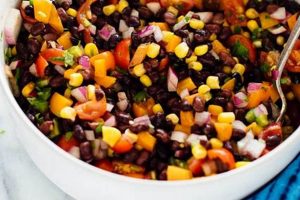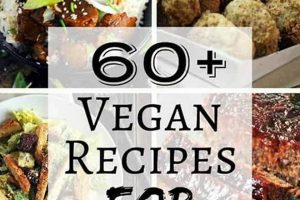Combinations of whole grains, plant-based proteins, fresh vegetables, and flavorful sauces provide nourishing and versatile meals. These customizable dishes offer a convenient way to consume a balanced diet while adhering to plant-based dietary guidelines. For example, a bowl may include quinoa, chickpeas, roasted sweet potatoes, spinach, and a tahini dressing.
The appeal of such dishes lies in their adaptability to various preferences and nutritional needs. They provide a good source of fiber, vitamins, and minerals, supporting overall health and well-being. Historically, variations of these meals have existed in numerous cultures, utilizing locally available grains and plant-based ingredients.
The following will delve into the core components, preparation techniques, and flavor profiles commonly associated with these plant-based meal creations.
Guidance for Optimal Composition
The creation of satisfying and nutritious plant-based meals requires careful consideration of ingredient selection and preparation methods. The following guidance aims to enhance the quality and appeal of such dishes.
Tip 1: Grain Selection. Prioritize whole grains such as quinoa, brown rice, or farro as a base. These provide sustained energy and dietary fiber, promoting satiety.
Tip 2: Protein Integration. Incorporate plant-based protein sources such as lentils, chickpeas, black beans, or tofu. Adequate protein intake is essential for muscle maintenance and repair.
Tip 3: Vegetable Variety. Include a diverse range of colorful vegetables, both raw and cooked. Different colors indicate varying nutrient profiles; aim for a rainbow of options.
Tip 4: Flavor Enhancement. Utilize herbs, spices, and flavorful sauces to elevate the taste profile. Consider options such as tahini dressing, pesto, or a lemon-herb vinaigrette.
Tip 5: Texture Contrast. Introduce textural elements such as toasted nuts or seeds for added crunch and nutritional value. This contributes to a more satisfying eating experience.
Tip 6: Portion Control. Be mindful of portion sizes to maintain a balanced caloric intake. A general guideline is to fill the bowl with approximately half vegetables, one-quarter grains, and one-quarter protein.
Tip 7: Ingredient Preparation. Consider roasting vegetables for enhanced flavor. Roasting brings out the natural sweetness of vegetables, making them more palatable and flavorful.
Adherence to these principles will result in a plant-based meal that is both nutritionally complete and gastronomically appealing, promoting long-term adherence to a plant-based dietary pattern.
The subsequent sections will explore specific considerations for recipe adaptation and meal planning.
1. Ingredient Selection
Ingredient selection is a foundational element in the successful creation and nutritional value of the meal being planned. The choice of specific ingredients directly affects the macronutrient profile, micronutrient density, and overall health benefits of the final dish. For the meals at hand, this means considering the source and quality of grains, plant-based proteins, vegetables, and dressings.
The cause-and-effect relationship is evident: selecting refined grains such as white rice versus whole grains such as quinoa results in a significant difference in fiber content and glycemic index. The selection of protein sources, such as opting for lentils over processed meat substitutes, impacts the amino acid profile and potential for added sodium or unhealthy fats. Examples include utilizing seasonal, locally sourced vegetables to maximize freshness and nutrient retention or choosing a homemade vinaigrette over a commercially produced dressing to control sugar and sodium levels. Understanding the impact of each ingredient on the final nutritional composition is of practical significance for individuals seeking to optimize their dietary intake.
In summary, careful ingredient selection is paramount for achieving both culinary satisfaction and nutritional adequacy when preparing these particular meals. Overlooking this critical aspect can negate the potential health benefits associated with a plant-based diet. Focus on natural whole foods for recipes.
2. Nutrient Balance
Nutrient balance represents a critical consideration in the preparation of meals centered around plant-based components. Attaining an appropriate ratio of macronutrients and micronutrients is essential for optimal health and well-being, particularly within the context of dietary patterns that exclude animal products.
- Macronutrient Proportions
The distribution of carbohydrates, proteins, and fats directly influences energy levels and satiety. Whole grains provide complex carbohydrates and fiber, while legumes, tofu, or tempeh contribute plant-based protein. Healthy fats are derived from sources such as avocados, nuts, and seeds. The proportions should be tailored to individual needs, typically emphasizing complex carbohydrates and adequate protein intake. For example, a meal comprising 50% whole grains, 25% plant-based protein, and 25% vegetables with healthy fats promotes sustained energy and balanced nutrition.
- Micronutrient Density
Ensuring sufficient intake of vitamins and minerals is crucial, especially nutrients often associated with animal products, such as vitamin B12, iron, and calcium. Including a diverse range of colorful vegetables provides a spectrum of vitamins and minerals. Fortified plant-based milk alternatives can serve as a source of vitamin B12 and calcium. Iron absorption from plant-based sources can be enhanced by consuming them with vitamin C-rich foods. Strategic ingredient combinations can maximize micronutrient availability and bioavailability.
- Amino Acid Completeness
Plant-based proteins may not always contain all nine essential amino acids in sufficient quantities. Combining different protein sources, such as grains and legumes, throughout the day ensures the intake of all essential amino acids. For instance, a combination of rice and beans provides a complete protein profile. This complementary approach is essential for supporting muscle protein synthesis and overall physiological function.
- Fiber Intake
Plant-based meals are often rich in dietary fiber, which is beneficial for digestive health, blood sugar control, and cholesterol management. Incorporating whole grains, vegetables, and legumes maximizes fiber intake. Excessive fiber consumption can, however, lead to gastrointestinal discomfort in some individuals. Gradual increases in fiber intake are recommended to allow the digestive system to adapt. Hydration also plays a key role in the processing of fibre in the body.
These facets are linked by the aim to optimize nutrient intake in a plant-based context. Effective meal construction takes these parameters into account, resulting in plates which are both nutritionally balanced and satisfying to the consumer. Addressing these key factors is integral to promoting long-term health and well-being for those following a vegan dietary pattern.
3. Flavor Combinations
Flavor pairings significantly influence the palatability and overall dining experience when preparing plant-based meals. The skillful combination of tastes and textures can transform simple ingredients into complex and satisfying meals. In the context of the dishes, these flavor pairings become essential for ensuring long-term adherence to a plant-based dietary pattern.
- Acidic Accents and Rich Bases
The integration of acidic elements, such as lemon juice or vinegar, with rich or fatty bases, like avocado or tahini, creates a balance that enhances the overall taste profile. For example, a tahini dressing with lemon juice poured over a dish containing roasted sweet potatoes and chickpeas provides a counterpoint to the sweetness of the potatoes and the earthiness of the chickpeas. This interplay stimulates the palate and prevents flavor fatigue.
- Herbal and Spice Infusion
The strategic use of herbs and spices introduces depth and complexity to plant-based dishes. Herbs such as cilantro, parsley, and mint offer fresh, aromatic notes, while spices such as cumin, coriander, and turmeric impart warmth and earthiness. For instance, adding a blend of cumin, coriander, and chili powder to roasted vegetables creates a flavor reminiscent of Southwestern cuisine. Careful consideration of herb and spice combinations can elevate a simple meal to a gourmet experience.
- Sweet and Savory Contrasts
The juxtaposition of sweet and savory elements offers a compelling flavor dynamic. Adding a touch of maple syrup or balsamic glaze to roasted vegetables, or incorporating dried fruits such as cranberries or raisins, provides a subtle sweetness that complements savory ingredients. For instance, a bowl featuring roasted Brussels sprouts with a drizzle of balsamic glaze and toasted pecans offers a complex interplay of sweet, savory, and nutty flavors.
- Umami Enrichment
Umami, often described as a savory or meaty flavor, can be achieved in plant-based dishes through the use of ingredients such as nutritional yeast, sun-dried tomatoes, or seaweed. These ingredients provide a depth of flavor that enhances the overall satisfaction of the meal. For instance, sprinkling nutritional yeast over a grain bowl adds a cheesy, umami-rich flavor that complements the other ingredients.
The purposeful application of these flavor combinations is a defining characteristic of well-executed plant-based food preparation. Through understanding the interactions between different tastes, one can create meals that are both nutritious and enjoyable, thereby promoting the sustained adoption of this particular dietary approach. Additional examples can be found in various ethnic cuisines, illustrating the diverse range of flavor pairings possible within a plant-based framework.
4. Texture variation
Texture variation is an essential element in the preparation of satisfying meals. Its presence directly impacts sensory perception and overall enjoyment. Within the context of these meal types, diverse textures prevent palate fatigue and enhance the dining experience. The incorporation of contrasting textures, such as the crispness of raw vegetables alongside the chewiness of cooked grains, creates a more stimulating sensory experience. This multi-textural approach encourages mindful eating and can contribute to a greater sense of satiety.
The application of texture variation involves strategic ingredient selection and preparation techniques. For example, toasting nuts or seeds provides a crunchy element that complements the softer textures of cooked grains and vegetables. Incorporating creamy components, such as avocado or hummus, adds a contrasting smoothness. Roasting vegetables intensifies their sweetness and creates a slightly charred, crisp exterior, further diversifying the textural profile. Consider a grain bowl comprised of fluffy quinoa, tender roasted sweet potatoes, crunchy toasted pecans, and creamy avocado. Each component contributes a distinct textural element, resulting in a more engaging and satisfying meal.
The integration of varied textures presents a subtle, yet crucial, aspect of plant-based recipe development. Emphasizing textural diversity transforms meals from simple nutritional provisions into sensory experiences, thus supporting long-term adherence to plant-based dietary patterns. Overlooking this aspect can lead to diminished satisfaction and potential abandonment of plant-based eating habits. The strategic combination of textures directly enhances palatability and overall meal enjoyment.
5. Preparation Method
Preparation methods profoundly affect the final outcome of the dish. Different techniques influence the taste, texture, and nutritional content of ingredients, all of which have significant consequences. For example, roasting vegetables caramelizes their natural sugars, enhancing sweetness and complexity. Steaming preserves nutrients but may result in a softer texture. Sauting allows for the development of layered flavors but requires careful attention to oil usage and heat control. The preparation method, therefore, is not merely a procedural step; it’s a determinant of the finished dishs overall quality.
Practical applications of varying preparation methods are numerous. The same vegetable, such as broccoli, can be transformed into different experiences based on the cooking approach. Raw broccoli offers a crisp texture and fresh taste, ideal for salads or slaws. Steamed broccoli becomes tender and mild, often served as a simple side dish. Roasted broccoli gains a slightly smoky flavor and crispy edges, making it a more assertive component. The specific recipe often dictates the most suitable technique. Bowls designed for warm flavors might benefit from roasted or sauted elements, while those aiming for freshness might prioritize raw or lightly steamed ingredients.
In summary, preparation methods are an integral component of plant-based dishes, impacting their sensory appeal and nutritional profile. The choice of cooking technique should be deliberate, aligning with the desired taste, texture, and nutritional goals of the recipe. Mastering various preparation methods expands culinary capabilities and allows for greater creativity and control in achieving optimal results. It is essential to understand the cause-and-effect relationships between cooking techniques and ingredient transformation to fully realize the potential of plant-based cuisine.
6. Visual appeal
The aesthetics of a dish, often denoted as visual appeal, significantly influences the perception of taste and overall satisfaction. This is particularly relevant for plant-based meals, where preconceived notions about flavor and texture might exist. A well-presented offering can overcome such biases and encourage consumption. Color contrasts, ingredient arrangement, and overall composition contribute to the attractiveness of the meal, thereby impacting the dining experience. For instance, layering vibrant vegetables atop a bed of grains, finished with a drizzle of brightly colored sauce, creates an inviting presentation. In contrast, a monochromatic or carelessly arranged plating may diminish the perceived quality of the same ingredients.
Effective creation involves strategic manipulation of color, texture, and arrangement. Utilizing a variety of colors, such as the red of bell peppers, the green of spinach, and the orange of carrots, creates visual interest and signals a diverse nutrient profile. Contrasting textures, such as the smoothness of avocado against the crunch of toasted seeds, add further appeal. The strategic arrangement of ingredients, either in distinct layers or a balanced mix, contributes to a sense of order and harmony. As an example, arranging colorful roasted vegetables in a radial pattern atop quinoa, topped with a vibrant herb dressing, transforms a simple meal into a visually stunning and appealing plate. Restaurants often employ specific plating techniques to enhance visual appeal, recognizing its impact on customer satisfaction. This focus on presentation extends to home cooking, where thoughtful plating can elevate the dining experience.
The connection between visual appeal and success in plant-based meal preparation highlights the importance of sensory presentation. While taste and nutritional value remain paramount, the visual aspect plays a critical role in shaping initial perceptions and overall satisfaction. Neglecting the visual appeal can result in undervaluing the culinary offering, potentially undermining the adoption and sustained practice of plant-based dietary patterns. Cultivating an awareness of design principles and incorporating them into plant-based food preparation is essential for both culinary professionals and home cooks seeking to maximize the appeal of their plant-based creations.
Frequently Asked Questions
The following addresses common inquiries related to plant-based dishes, providing concise answers to assist in preparation and understanding.
Question 1: What constitutes a “whole grain” in the context of plant-based meals?
A whole grain consists of the entire grain kernel the bran, germ, and endosperm. Examples include quinoa, brown rice, farro, and oats. Refined grains, such as white rice, have had the bran and germ removed, resulting in reduced fiber and nutrient content.
Question 2: Are specific protein sources superior to others in plant-based meal construction?
Variety is recommended. Legumes (lentils, chickpeas, beans), tofu, tempeh, and quinoa offer distinct amino acid profiles and nutritional benefits. Combining different protein sources throughout the day helps ensure intake of all essential amino acids.
Question 3: How does one address potential nutrient deficiencies, such as vitamin B12, in plant-based eating patterns?
Vitamin B12 is not naturally found in plant-based foods. Supplementation or consumption of fortified foods, such as plant-based milk alternatives, is essential to prevent deficiency.
Question 4: What strategies mitigate potential digestive discomfort associated with increased fiber intake when adopting plant-based meals?
Gradual increases in fiber intake allow the digestive system to adapt. Adequate hydration is also crucial for proper fiber processing. Soaking legumes before cooking can reduce indigestible compounds.
Question 5: Can plant-based meals be cost-effective?
Yes. Staples such as beans, lentils, and rice are generally less expensive than animal products. Seasonal produce and bulk purchasing can further reduce costs. Planning meals around affordable ingredients is a key strategy.
Question 6: How does roasting enhance the flavor of vegetables in such dishes?
Roasting caramelizes the natural sugars in vegetables, intensifying their sweetness and creating a slightly charred exterior. This results in a more complex and palatable flavor profile compared to other cooking methods such as boiling or steaming.
These answers serve as a foundational guide to common considerations within the realm of plant-based cuisine, offering practical insights for both novice and experienced practitioners.
The next section will transition to providing sample recipes, incorporating the principles discussed herein.
Conclusion
The preceding exploration has detailed various aspects of vegan grain bowls recipes, from foundational principles of ingredient selection and nutrient balance to nuanced considerations of flavor combinations, texture variation, preparation methods, and visual appeal. These elements, when thoughtfully integrated, contribute to the creation of nutritionally complete and gastronomically satisfying plant-based meals.
Mastery of these techniques is crucial for those seeking to incorporate vegan grain bowls recipes into a sustainable dietary pattern. Ongoing experimentation and adaptation are encouraged to refine individual preferences and maximize the benefits derived from this versatile culinary approach. The potential for enhanced health and dietary satisfaction warrants continued exploration of this culinary domain.







